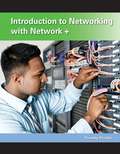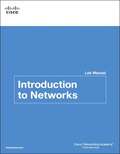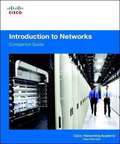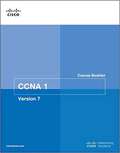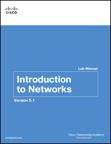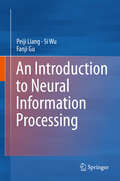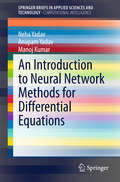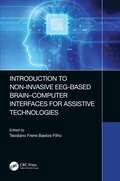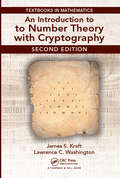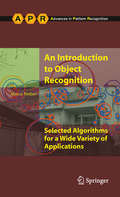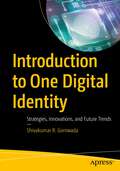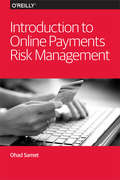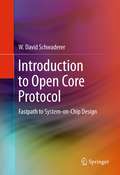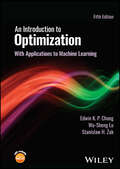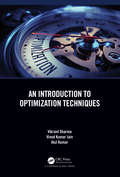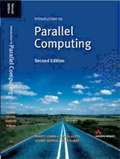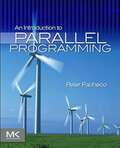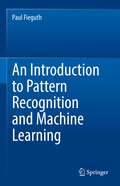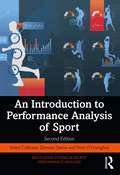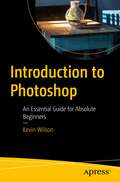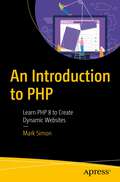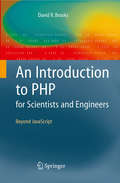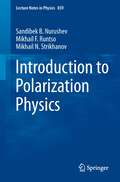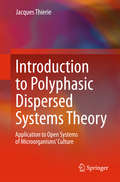- Table View
- List View
Introduction To Networking With Network+
by Microsoft Official Academic Course Staff Timothy PintelloIntroduction to Networking with Network + is the cornerstone for your networking curriculum. It is built around the new Network+ 2012 framework. It is based upon the CompTIA Network+ certification and covers the most recent exam objectives. Are you tired of books that cover new technologies and exam topics in a fleeting fashion, and are bogged down with legacy technology coverage that is now out-dated? This book by Timothy Pintello is up-to-date and covers only relevant and current technologies. This book also includes his revolutionary method for making Subnetting easily understood by new IT
Introduction to Networks: Lab Manual, v5.0
by Cisco Networking Academy Program StaffThe Introduction to Networks Lab Manual provides students enrolled in a Cisco Networking Academy Introduction to Networks course with a convenient, complete collection of all the course lab exercises that provide hands-on practice and challenges.
Introduction to Networks Companion Guide [Cisco Networking Academy Series]
by Cisco Networking AcademyIntroduction to Networks Companion Guide is the official supplemental textbook for the Introduction to Networks course in the Cisco® Networking Academy® CCNA® Routing and Switching curriculum. The course introduces the architecture, structure, functions, components, and models of the Internet and computer networks.
Introduction to Networks Course Booklet (CCNA)
by Cisco Networking AcademyYour Cisco Networking Academy® Course Booklet is designed as a study resource you can easily read, highlight, and review on the go, wherever the Internet is not available or practical: The text is extracted directly, word-for-word, from the online course so you can highlight important points and take notes in the “Your Chapter Notes” section. Headings with the exact page correlations provide a quick reference to the online course for your classroom discussions and exam preparation. An icon system directs you to the online curriculum to take full advantage of the images embedded within the Networking Academy online course interface and reminds you to do the labs, interactive activities, packet tracer activities, watch videos, and take the chapter quizzes. <p><p> The Course Booklet is a basic, economical paper-based resource to help you succeed with the Cisco Networking Academy online course. <p><p> This book is offered exclusively for students enrolled in Cisco Networking Academy courses. It is not designed for independent study or professional certification preparation. Visit netacad.com to learn more about program options and requirements.
Introduction to Networks Lab Manual, Version 5.1
by Cisco Networking AcademyThis manual provides students enrolled in a Cisco Networking Academy Introduction to Networks course with a convenient, complete collection of all the course lab exercises that provide hands-on practice and challenges.
An Introduction to Neural Information Processing
by Fanji Gu Peiji Liang Si WuThis book provides an overview of neural information processing research, which is one of the most important branches of neuroscience today. Neural information processing is an interdisciplinary subject, and the merging interaction between neuroscience and mathematics, physics, as well as information science plays a key role in the development of this field. This book begins with the anatomy of the central nervous system, followed by an introduction to various information processing models at different levels. The authors all have extensive experience in mathematics, physics and biomedical engineering, and have worked in this multidisciplinary area for a number of years. They present classical examples of how the pioneers in this field used theoretical analysis, mathematical modeling and computer simulation to solve neurobiological problems, and share their experiences and lessons learned. The book is intended for researchers and students with a mathematics, physics or informatics background who are interested in brain research and keen to understand the necessary neurobiology and how they can use their specialties to address neurobiological problems. It is also provides inspiration for neuroscience students who are interested in learning how to use mathematics, physics or informatics approaches to solve problems in their field.
An Introduction to Neural Network Methods for Differential Equations (SpringerBriefs in Applied Sciences and Technology)
by Manoj Kumar Neha Yadav Anupam YadavThis book introduces a variety of neural network methods for solving differential equations arising in science and engineering. The emphasis is placed on a deep understanding of the neural network techniques, which has been presented in a mostly heuristic and intuitive manner. This approach will enable the reader to understand the working, efficiency and shortcomings of each neural network technique for solving differential equations. The objective of this book is to provide the reader with a sound understanding of the foundations of neural networks and a comprehensive introduction to neural network methods for solving differential equations together with recent developments in the techniques and their applications. The book comprises four major sections. Section I consists of a brief overview of differential equations and the relevant physical problems arising in science and engineering. Section II illustrates the history of neural networks starting from their beginnings in the 1940s through to the renewed interest of the 1980s. A general introduction to neural networks and learning technologies is presented in Section III. This section also includes the description of the multilayer perceptron and its learning methods. In Section IV, the different neural network methods for solving differential equations are introduced, including discussion of the most recent developments in the field. Advanced students and researchers in mathematics, computer science and various disciplines in science and engineering will find this book a valuable reference source.
Introduction to Non-Invasive EEG-Based Brain-Computer Interfaces for Assistive Technologies
by Teodiano Freire Bastos-FilhoThis book aims to bring to the reader an overview of different applications of brain-computer interfaces (BCIs) based on more than 20 years of experience working on these interfaces. The author provides a review of the human brain and EEG signals, describing the human brain, anatomically and physiologically, with the objective of showing some of the patterns of EEG (electroencephalogram) signals used to control BCIs. It then introduces BCIs and different applications, such as a BCI based on ERD/ERS Patterns in α rhythms (used to command a robotic wheelchair with an augmentative and alternative communication (AAC) system onboard it); a BCI based on dependent-SSVEP to command the same robotic wheelchair; a BCI based on SSVEP to command a telepresence robot and its onboard AAC system; a BCI based on SSVEP to command an autonomous car; a BCI based on independent-SSVEP (using Depth-of-Field) to command the same robotic wheelchair; the use of compressive technique in SSVEP-based BCI; a BCI based on motor imagery (using different techniques) to command a robotic monocycle and a robotic exoskeleton; and the first steps to build a neurorehabilitation system based on motor imagery of pedalling together an in immersive virtual environment. This book is intended for researchers, professionals and students working on assistive technology.
An Introduction to Number Theory with Cryptography (Textbooks in Mathematics)
by James Kraft Lawrence Washington<p>Building on the success of the first edition, An Introduction to Number Theory with Cryptography, Second Edition, increases coverage of the popular and important topic of cryptography, integrating it with traditional topics in number theory. <p>The authors have written the text in an engaging style to reflect number theory's increasing popularity. The book is designed to be used by sophomore, junior, and senior undergraduates, but it is also accessible to advanced high school students and is appropriate for independent study. It includes a few more advanced topics for students who wish to explore beyond the traditional curriculum.</p>
An Introduction to Object Recognition: Selected Algorithms for a Wide Variety of Applications (Advances in Computer Vision and Pattern Recognition)
by Marco Alexander TreiberRapid development of computer hardware has enabled usage of automatic object recognition in an increasing number of applications, ranging from industrial image processing to medical applications, as well as tasks triggered by the widespread use of the internet. Each area of application has its specific requirements, and consequently these cannot all be tackled appropriately by a single, general-purpose algorithm. This easy-to-read text/reference provides a comprehensive introduction to the field of object recognition (OR). The book presents an overview of the diverse applications for OR and highlights important algorithm classes, presenting representative example algorithms for each class. The presentation of each algorithm describes the basic algorithm flow in detail, complete with graphical illustrations. Pseudocode implementations are also included for many of the methods, and definitions are supplied for terms which may be unfamiliar to the novice reader. Supporting a clear and intuitive tutorial style, the usage of mathematics is kept to a minimum. Topics and features: presents example algorithms covering global approaches, transformation-search-based methods, geometrical model driven methods, 3D object recognition schemes, flexible contour fitting algorithms, and descriptor-based methods; explores each method in its entirety, rather than focusing on individual steps in isolation, with a detailed description of the flow of each algorithm, including graphical illustrations; explains the important concepts at length in a simple-to-understand style, with a minimum usage of mathematics; discusses a broad spectrum of applications, including some examples from commercial products; contains appendices discussing topics related to OR and widely used in the algorithms, (but not at the core of the methods described in the chapters). Practitioners of industrial image processing will find this simple introduction and overview to OR a valuable reference, as will graduate students in computer vision courses. Marco Treiber is a software developer at Siemens Electronics Assembly Systems, Munich, Germany, where he is Technical Lead in Image Processing for the Vision System of SiPlace placement machines, used in SMT assembly.
Introduction to One Digital Identity: Strategies, Innovations, and Future Trends
by Shivakumar R. GoniwadaExplore the dynamics of digital identity, a crucial component in today’s modern technology-driven era. This engaging book offers a deep understanding of how digital identity is evolving rapidly, why it’s so significant, and offers organizations, regulatory bodies, and academicians the strategies needed to adopt secure decentralized digital identity features effectively. It’s a must-read for those aiming to grasp the intricacies of digital identity and leverage it for future innovation and security.The book begins by redefining digital identity, examining its evolution and the profound impact it has on both individuals and organizations. It then delves into the development of digital identity strategies, laying the foundation for future digital transformations. Covering a wide range of topics, the book discusses the innovation, challenges, and technological exploration in digital identity. A special focus is given to biometric technologies and the implementation of decentralized digital identities, addressing critical areas such as identity governance, blockchain, AI and advanced biometrics. The book also investigates the implications of digital identity across various industries, including cross border travel, healthcare, social media, finance, metaverse, IoT etc. finally the book provides not only emerging trends but offers a glimpse into the future digital identity. Whether you’re a tech professional, business leader, student or simply keen on understanding the impact of digital advancements, this book promises to offer insightful perspectives and practical solutions for navigating the complex world of digital identity. It underscores the importance of identity in spearheading digital innovation, making it a key resource for anyone looking to stay ahead in the digital landscape. As you reach its conclusion, you’ll be equipped with a wealth of knowledge and insights that are crucial in today’s digital era.What You'll LearnDigital identity strategies and their role in shaping the future of digital identityDifferent facets of digital identitySpecifics of biometric technologies and decentralized digital identity Industry specific digital identity and its implementationCrucial aspects of privacy, ethics, and secure in the context of digital identityWho This Book Is ForSoftware professionals, security practitioners, architects, senior managers, executives, and students who are interested in digital identity.
Introduction to Online Payments Risk Management
by Ohad SametIf you've been tasked with building a team to handle risk management for online payments (RMP), this practical introduction provides a framework for choosing the technologies and personnel you need. Author and financial services executive Ohad Samet explains the components of payments risk management, and presents a coherent strategy and operational approach. You'll learn the answers to questions you're likely to encounter in the first 18 months of operation, with information that Samet has shaped and tested over several years in the industry. This book is ideal whether you intend to be a one-person task force or work with dozens of agents and analysts. Use both a portfolio and behavioral approach to analyzing and optimizing losses Learn about your customers to determine if they can and will meet obligations Build an RMP team for payment risk operations, analytics, and decision automation Use linking mechanisms and velocity models to detect unusual activity among your customers Design system and data architecture to facilitate your activity analysis Implement the decision and loss-reduction mechanisms you need to act on your findings
Introduction to Open Core Protocol
by W David SchwadererThis book introduces Open Core Protocol (OCP) not as a conventional hardware communications protocol but as a meta-protocol: a means for describing and capturing the communications requirements of an IP core, and mapping them to a specific set of signals with known semantics. Readers will learn the capabilities of OCP as a semiconductor hardware interface specification that allows different System-On-Chip (SoC) cores to communicate. The OCP methodology presented enables intellectual property designers to design core interfaces in standard ways. This facilitates reusing OCP-compliant cores across multiple SoC designs which, in turn, drastically reduces design times, support costs, and overall cost for electronics/SoCs.
An Introduction to Optimization: With Applications to Machine Learning (Wiley Series In Discrete Mathematics And Optimization Ser. #77)
by Edwin K. Chong Wu-Sheng Lu Stanislaw H. ŻakAn Introduction to Optimization Accessible introductory textbook on optimization theory and methods, with an emphasis on engineering design, featuring MATLAB® exercises and worked examples Fully updated to reflect modern developments in the field, the Fifth Edition of An Introduction to Optimization fills the need for an accessible, yet rigorous, introduction to optimization theory and methods, featuring innovative coverage and a straightforward approach. The book begins with a review of basic definitions and notations while also providing the related fundamental background of linear algebra, geometry, and calculus. With this foundation, the authors explore the essential topics of unconstrained optimization problems, linear programming problems, and nonlinear constrained optimization. In addition, the book includes an introduction to artificial neural networks, convex optimization, multi-objective optimization, and applications of optimization in machine learning. Numerous diagrams and figures found throughout the book complement the written presentation of key concepts, and each chapter is followed by MATLAB® exercises and practice problems that reinforce the discussed theory and algorithms. The Fifth Edition features a new chapter on Lagrangian (nonlinear) duality, expanded coverage on matrix games, projected gradient algorithms, machine learning, and numerous new exercises at the end of each chapter. An Introduction to Optimization includes information on: The mathematical definitions, notations, and relations from linear algebra, geometry, and calculus used in optimization Optimization algorithms, covering one-dimensional search, randomized search, and gradient, Newton, conjugate direction, and quasi-Newton methods Linear programming methods, covering the simplex algorithm, interior point methods, and duality Nonlinear constrained optimization, covering theory and algorithms, convex optimization, and Lagrangian duality Applications of optimization in machine learning, including neural network training, classification, stochastic gradient descent, linear regression, logistic regression, support vector machines, and clustering. An Introduction to Optimization is an ideal textbook for a one- or two-semester senior undergraduate or beginning graduate course in optimization theory and methods. The text is also of value for researchers and professionals in mathematics, operations research, electrical engineering, economics, statistics, and business.
An Introduction to Optimization Techniques
by Vikrant Sharma Vinod Kumar Jain Atul KumarAn Introduction to Optimization Techniques introduces the basic ideas and techniques of optimization. Optimization is a precise procedure using design constraints and criteria to enable the planner to find the optimal solution. Optimization techniques have been applied in numerous fields to deal with different practical problems. This book is designed to give the reader a sense of the challenge of analyzing a given situation and formulating a model for it while explaining the assumptions and inner structure of the methods discussed as fully as possible. It includes real-world examples and applications making the book accessible to a broader readership. Features Each chapter begins with the Learning Outcomes (LO) section, which highlights the critical points of that chapter. All learning outcomes, solved examples and questions are mapped to six Bloom Taxonomy levels (BT Level). Book offers fundamental concepts of optimization without becoming too complicated. A wide range of solved examples are presented in each section after the theoretical discussion to clarify the concept of that section. A separate chapter on the application of spreadsheets to solve different optimization techniques. At the end of each chapter, a summary reinforces key ideas and helps readers recall the concepts discussed. The wide and emerging uses of optimization techniques make it essential for students and professionals. Optimization techniques have been applied in numerous fields to deal with different practical problems. This book serves as a textbook for UG and PG students of science, engineering, and management programs. It will be equally useful for Professionals, Consultants, and Managers.
Introduction to Parallel Computing (Second Edition)
by Ananth Grama Anshul Gupta George Karypis Vipin KumarIntroducation to Parallel Computing is a complete end-to-end source of information on almost all aspects of parallel computing from introduction to architectures to programming paradigms to algorithms to programming standards. It covers traditional Computer Science algorithms, scientific computing algorithms, and data intensive algorithms.
An Introduction to Parallel Programming
by Peter PachecoAn Introduction to Parallel Programming by Pacheco, Peter
An Introduction to Pattern Recognition and Machine Learning
by Paul FieguthThe domains of Pattern Recognition and Machine Learning have experienced exceptional interest and growth, however the overwhelming number of methods and applications can make the fields seem bewildering. This text offers an accessible and conceptually rich introduction, a solid mathematical development emphasizing simplicity and intuition. Students beginning to explore pattern recognition do not need a suite of mathematically advanced methods or complicated computational libraries to understand and appreciate pattern recognition; rather the fundamental concepts and insights, eminently teachable at the undergraduate level, motivate this text. This book provides methods of analysis that the reader can realistically undertake on their own, supported by real-world examples, case-studies, and worked numerical / computational studies.
An Introduction to Performance Analysis of Sport (Routledge Studies in Sports Performance Analysis)
by Adam Cullinane Gemma Davies Peter O'DonoghuePerformance analysis has become an essential tool for coaches, athletes, sports organisations and academic researchers. Collecting and interpreting performance data enables coaches to improve their training programmes, athletes to make better tactical decisions, sports organisations to manage teams more effectively and researchers to develop a better understanding of sports performance. This fully revised new edition is an essential introduction to the fundamental principles of performance analysis of sport and how to develop and operate performance analysis systems.Containing worked examples from real sporting events as well as new content examining innovations in determining what to analyse, advances in feedback technology, performance profiles, principles for delivering feedback and telestration within video sequences, An Introduction to Performance Analysis of Sport reviews the different types of data and information that performance analysis can generate and explains how to test for reliability.This cutting-edge book presents a step-by-step guide to developing both manual and computerised analysis systems and writing up and presenting findings from performance analysis programmes. Representing the most up-to-date, concise and engaging introduction to sports performance analysis, this book is an ideal course text for all introductory performance analysis courses, as well as an invaluable primer for coaches and practitioners in sport.
Introduction to Photography: A Visual Guide to the Essential Skills of Photography and Lightroom
by Mark GalerThis book is intended to be the primary textbook to support any college who would like to run a Photography 101 course for students. The course is designed to offer tutors an independent learning tool to enable students to learn the craft of using an interchangeable lens camera (DSLR or Mirrorless) and the basics of an image-editing program (Adobe Lightroom) to enable them to take creative control of the imaging process. The curriculum offers a step-by-step and jargon-free approach to learning the fundamental skills of creative camera control. Each page features a large image with a brief explanation of how the creative controls of the camera have led to the resulting visual appearance of the image. Information on each page is stripped down the essentials and text is carefully selected to be unambiguous and kept to the bare minimum to ensure rapid acquisition of the skills on offer. This effective course-in-a-book allows students quickly to become technically proficient, and instructors to efficiently evaluate students' progress.
Introduction to Photoshop: An Essential Guide for Absolute Beginners
by Kevin WilsonThis full-color book is an essential guide to getting started with Adobe Photoshop. It's packed with tutorials, illustrations, and practical exercises to help you make sense of this complex and powerful software.You'll start with the basics of Photoshop, including an overview of its myriad tools and other options. Next, you will learn about some of the common tasks that can be performed in Photoshop, such as how to touch up images and basic applications in photography. You'll also be walked through how to leverage Photoshop for special and 3D effects. Each and every technique author Kevin Wilson presents is illustrated step-by-step using screenshots with concise, easy to follow text. Downloadable sample photoshop files and images are also provided, to help you work your way through the book.Whether you are a graphic design student, a photographer, or just a keen computer user, this book will provide you with a firm grasp of the underpinning foundations of Photoshop and equip you with the skills needed to unleash its full power.What You Will LearnUnderstand Photoshop's many toolsUse Photoshop to execute common image manipulation tasks Touch up photographs and other images in PhotoshopRemove lens distortion and make photos look more professionalWho This Book Is ForStudents, those interested in starting graphic design, and photographers looking to enhance, clean up and manipulate their photos. No experience with image-manipulation software is needed.
An Introduction to PHP: Learn PHP 8 to Create Dynamic Websites
by Mark SimonUse PHP to enhance your web pages. This book shows you how PHP programming works, and how to write and organize PHP code. The book starts with steps to download and install a setup for a sample website that will form the basis for upcoming chapters. You start by writing PHP code and learn how to mix it with HTML and manage the code. From there, you will learn about dynamic content, along with a deep dive into form processing and sending email. Saving uploaded data and uploading files is discussed next. You will learn how to configure your PHP project and develop a library. You will then learn how to create an image catalog and manage data on your web page. By the end of the book, you will understand how to work with cookies, sessions, and logging in, followed by an example of creating a simple blog that reiterates the concepts developed in the previous chapters.After reading this book, you will be able to configure, create, and manage your dynamic website.What Will You LearnKnow the basics of programming with the PHP languageUse PHP to generate dynamic web pagesWork with SQL databasesWork with forms to upload text data and binary filesUse tips and tricks to write clean and maintainable codeWho This Book Is ForWeb developers and students learning to develop and maintain PHP code on their website
An Introduction to PHP for Scientists and Engineers: Beyond JavaScript
by David R. BrooksThis book provides an introduction to PHP and server-side programming. It presents readers with a science or engineering background with the information to write their own online applications requiring reading, creating and manipulating data files stored as text on a server, overcoming the limitations of a client-side language. It focuses only on those elements of the language, such as file input/output, arrays, built-in math functions, and user-created functions that are essential for solving a wide range of scientific/engineering computing problems - and assumes a working knowledge of programming concepts and HTML, JavaScript, C or a similar language. It contains complete applications and hence offers a very compact and efficient way for working professionals to take advantage of the possibilities offered by server-side programming. Written for a technical audience, this book is an effective learning tool to the essentials of PHP and is also ideal for self-study.
Introduction to Polarization Physics
by Sandibek B. Nurushev Mikhail F. Runtso Mikhail N. StrikhanovThis book is devoted to the polarization (spin) physics of high energy particles and contains three parts. The first part presents the theoretical prefaces of polarization in the particle physics for interpretations, predictions and bases for understanding the following two parts. The second part of the book presents the description of the essential polarization experiments including the recent ones. This part is devoted to the innovative instrumentations, gives the parameters of the polarized beams, targets, polarized gas jets and polarimeters. The third part of the book concentrates on the important achievements in polarization physics. The book can be used in lectures on nuclear and particle physics and and nuclear instruments and methods. As supplementary reading this book is useful for researchers working in particle and nuclear physics.
Introduction to Polyphasic Dispersed Systems Theory
by Jacques ThierieThis book introduces a new paradigm in system description and modelling. The author shows the theoretical and practical successes of his approach, which involves replacing a traditional uniform description with a polyphasic description. This change of perspective reveals new fluxes that are cryptic in the classical description. Several case studies are given in this book, which is of interest of those working with biotechnology and green chemistry.
